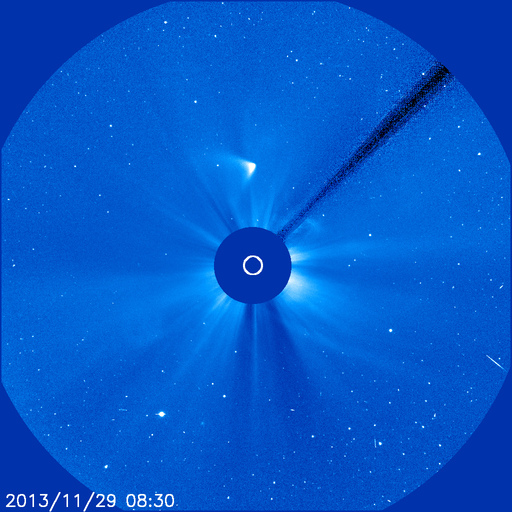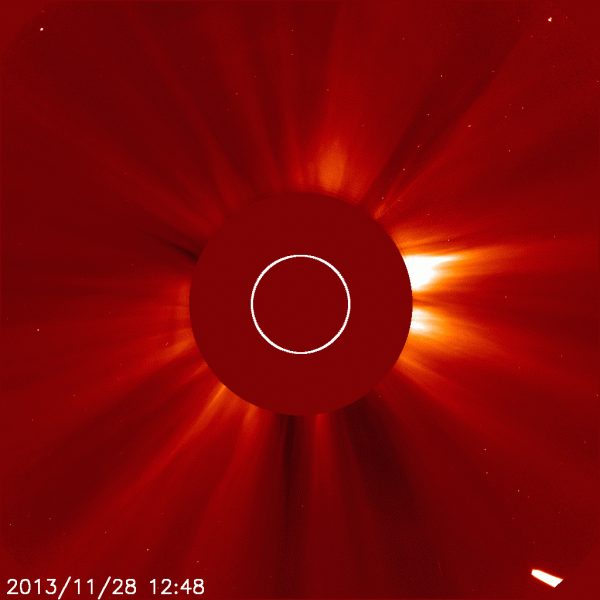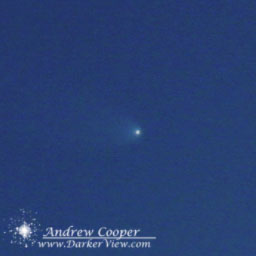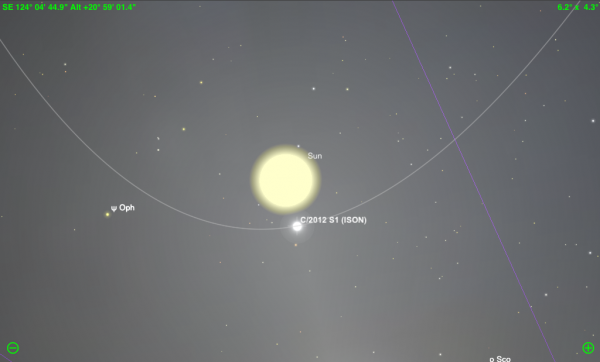Fragmented? Probably.
There seems to be something left of comet ISON, perhaps some large fragments. Dimmer than it was going in, more spread out. But something is generating a coma that shows up in the SOHO LASCO C3 imagery.

When you want to see the stars, find someplace dark
Fragmented? Probably.
There seems to be something left of comet ISON, perhaps some large fragments. Dimmer than it was going in, more spread out. But something is generating a coma that shows up in the SOHO LASCO C3 imagery.


Like many I was watching as comet ISON passed through perihelion. A better show than many other holiday offerings. It is clear that the comet has failed to survive perihelion passage. Disrupted by tidal forces and the extreme solar heating, the comet appears to have come apart even before closest approach.
I have assembled a better resolution animation of the demise of ISON from SOHO LASCO C2 imagery. Fifty frames at the full 1k x 1k resolution of the camera that shows the event from entry to exit from the field of view. Click on the image below for the full resolution version.
Note the lack of a distinct coma, simply a smeared out debris cloud. A cloud of debris and fragments continues along the original orbit. How large are some of these fragments? This is a question that may have to wait for a few days, allowing observations from a larger telescope further from the Sun.
Best laid plans? Not much hope remains for dawn photos as the comet emerges from the Sun’s glare. There remains comet C/2013 R1 Lovejoy in the morning sky, perhaps another photo session?

It does appear that comet C/2012 S1 ISON has come apart at perihelion. Imagery shows the comet coma dimming and smearing out as if the nucleus has totally disrupted. Even worse, the SDO imagery programmed to cover perihelion very near the sun show nothing. The SDO cameras are very good at this sort of thing, it should show traces even if the nucleus had been stripped of the tail by the solar wind.
So long ISON?

Today comet C/2012 S1 ISON will pass through perihelion, its closest approach to the Sun.
At a mere 1,800,000km (1,100,000miles) this will be a close pass indeed. As perihelion is measured from center to center, the distance is even closer if you consider the 695,500km (432,200mile) radius of the Sun. Subtracting the solar radius you realize the comet will pass a mere 1,100,000km (680,000miles) above the surface of the Sun. At this distance the intensity of the solar radiation will be nineteen thousand times more intense than a sunny day on Earth. Hot indeed!!

At closest approach the comet will be less than a degree from the Sun, difficult to pick out. An observers best bet will be as it approaches and as it moves away from the solar disk. As the comet nears perihelion it will approach the Sun from the west, best seen in the dawn sky. After perihelion it will exit the Sun’s vicinity to the north, favoring northern hemisphere observers.
The comet should be spectacular in the cameras of the dedicated solar observation satellites. Check out the real time views from SOHO or Stereo.
All sky-watchers are hoping that comet ISON is spectacular when it emerges from the solar glare. there is no guarantee on this, we just do not know. But it could be as pretty as comet Ikeya-Seki or comet McNaught, both of which became far brighter after perihelion passage.

This recent Saturday I only went partway up the Mauna Kea access road, just high enough to be clear of the clouds and haze. There is a turnoff on the east side of the road just above the cattle guard at about 8,000 ft, one mile below Hale Pohaku. Plenty of room to park a vehicle or two and plenty of level ground to take photos from.
Plotted below is the path of comet ISON through perihelion. The image is zenith up on the morning of November 28th from the island of Hawai’i. The actual moment of perihelion will be Nov 28.77501UT (18:36UT or 08:36HST).
A few things are notable… The obvious one is how close the comet will get to the Sun. Not just in absolute terms, which is really close. But rather how close it will look to us. The comet will be under 30 arc-minutes from the center of the Sun, recalling that the Sun is about 30 arc-minutes across. The comet will not pass behind the Sun from our point of view. While we may not be able to see it while lost in the solar glare, it will remain in the view of those solar monitoring spacecraft that are near the Earth.
Separation will help in trying to spot the comet during the day. During the 27th, 28th and 29th the comet will be very close to the Sun. On the morning of the 29th the comet will be only 4.5° from the Sun. Best bet to attempt a daytime peek may be on the 30th or later, when the comet will again be more than 7.5° from the Sun. Look for the magnitude estimates and be prepared to give it a look.
